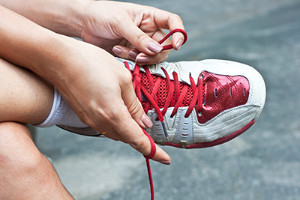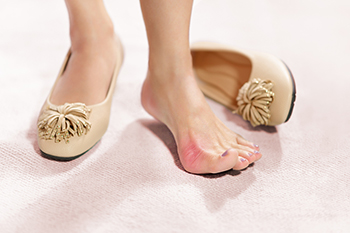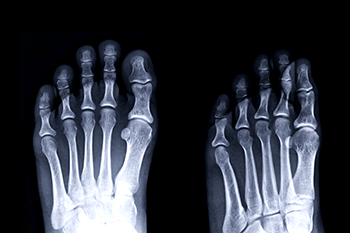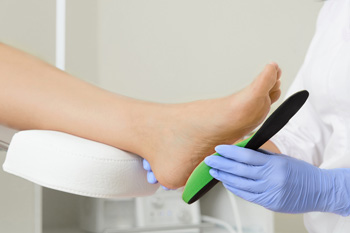
Many individuals might be candidates for different kinds of surgical procedures for the feet. These procedures can treat a wide variety of foot afflictions and might be necessary for some patients to heal from their condition. After you undergo a foot surgery, your podiatrist might recommend a variety of things that you can do post-surgery to help facilitate the healing and recovery process. For example, they might recommend performing certain physical exercises after foot surgery. They may also recommend exercising underwater, which reduces the amount of weight one puts on their feet. They might also recommend exercising your abdominals, which can ultimately increase stability and make walking easier. However, it is important to note that each person is uniquely different and one ought to closely follow the advice given by their podiatrist.
Foot surgery is sometimes necessary to treat a foot ailment. To learn more, contact Howard Waxman, DPM of Pleasant Valley Podiatry. Our doctor will assist you with all of your foot and ankle needs.
When Is Surgery Necessary?
Foot and ankle surgery is generally reserved for cases in which less invasive, conservative procedures have failed to alleviate the problem. Some of the cases in which surgery may be necessary include:
What Types of Surgery Are There?
The type of surgery you receive will depend on the nature of the problem you have. Some of the possible surgeries include:
Benefits of Surgery
Although surgery is usually a last resort, it can provide more complete pain relief compared to non-surgical methods and may allow you to finally resume full activity.
Surgical techniques have also become increasingly sophisticated. Techniques like endoscopic surgery allow for smaller incisions and faster recovery times.
If you have any questions please feel free to contact one of our offices located in Willoughby Hills and Broadview Heights, OH . We offer the newest diagnostic and treatment technologies for all your foot and ankle needs.

Blisters are quite a common form of foot affliction that can affect a wide variety of people. Blisters are filled with fluid and often develop on the feet in response to friction placed on the affected area. Other times, blisters can form on the feet in response to burns. Some individuals with this condition have the urge to pop these blisters. However, it is important to note that popping certain kinds of blisters is not recommended and may be dangerous. For example, it is generally not advisable to pop a burn blister. These blisters can be highly susceptible to infection. Sometimes, these blisters might pop on their own. In this case, you might consider keeping the blister covered. Maintaining moisture in the wound, perhaps with ointment, might also be beneficial. Contact a podiatrist today for more information.
Blisters are prone to making everyday activities extremely uncomfortable. If your feet are hurting, contact Howard Waxman, DPM of Pleasant Valley Podiatry. Our doctor can provide the care you need to keep you pain-free and on your feet.
Foot Blisters
Foot blisters develop as a result of constantly wearing tight or ill-fitting footwear. This happens due to the constant rubbing from the shoe, which can often lead to pain.
What Are Foot Blisters?
A foot blister is a small fluid-filled pocket that forms on the upper-most layer of the skin. Blisters are filled with clear fluid and can lead to blood drainage or pus if the area becomes infected.
How Do Blisters Form?
Blisters on the feet are often the result of constant friction of skin and material, usually by shoe rubbing. Walking in sandals, boots, or shoes that don’t fit properly for long periods of time can result in a blister. Having consistent foot moisture and humidity can easily lead to blister formation.
Prevention & Treatment
It is important to properly care for the affected area in order to prevent infection and ease the pain. Do not lance the blister and use a Band-Aid to provide pain relief. Also, be sure to keep your feet dry and wear proper fitting shoes. If you see blood or pus in a blister, seek assistance from a podiatrist.
If you have any questions, please feel free to contact one of our offices located in Willoughby Hills and Broadview Heights, OH . We offer the newest diagnostic and treatment technologies for all your foot care needs.

There are basic things to look for when purchasing running shoes. It is important to decide what type of running will be practiced, and this generally consists of mileage that is high, medium, or low. This is followed by choosing a shoe that will fit your foot, such as having a wider toe box, or a certain type of heel. Additionally, the type of surface that is run on will determine what type of shoe to buy. Running on pavements will require road shoes to be worn, and these are adequate in providing shock absorption. Trail shoes are designed to be worn while running through soft muddy trails, and wearing hybrid shoes is recommended for running on various surfaces. It is beneficial to bring the socks that are worn to try on with the shoes, in addition to bringing insoles, if applicable. If you would like more information about what type of shoes to buy for specific types of running, please consult with a podiatrist who can help you to make choices that are right for you.
You should always make sure your running shoes fit properly in order to avoid injury. For more information, contact Howard Waxman, DPM from Pleasant Valley Podiatry. Our doctor can provide the care you need to keep you pain-free and on your feet.
Choosing the Right Running Shoe for Your Foot Type
Improper shoe sizing can cause a myriad of problems for your feet. Shoes that don’t fit you properly can lead to muscular imbalances in your body, which can result in foot, knee, and hip injuries.
Tips for Finding the Right Running Shoe
If you have any questions please feel free to contact our one of our offices located in Willoughby Hills and Broadview Heights, OH . We offer the newest diagnostic and treatment technologies for all your foot and ankle needs.

A bunion is a foot condition involving a bony protrusion on the side of the big toe and is easy to notice. It is considered to be a deformity, and may cause the toes to shift towards each other. A common reason why people can develop bunions is from wearing shoes that are too small in the toe area. This can force the toes to squeeze together, and be uncomfortable. In severe cases, walking may become difficult, and larger shoes may need to be purchased that can accommodate the bunion. Research has shown that family genes may contribute to developing a bunion. Additionally, arthritis may lead to getting a bunion, as a result of inflamed toe joints. Symptoms of this ailment can include pain and swelling surrounding the big toe, and there may be calluses and corns that form on top of the bunion as it touches the side of the shoe. Mild relief may come from wearing a protective pad over the bunion, and orthotics may be prescribed that may help to realign the foot structure. If you have a bunion, it is strongly urged that you contact a podiatrist who can recommend the correct treatment options, which may include surgery for permanent removal.
If you are suffering from bunion pain, contact Howard Waxman, DPM of Pleasant Valley Podiatry. Our doctor can provide the care you need to keep you pain-free and on your feet.
What Is a Bunion?
Bunions are painful bony bumps that usually develop on the inside of the foot at the joint of the big toe. As the deformity increases over time, it may become painful to walk and wear shoes. Women are more likely to exacerbate existing bunions since they often wear tight, narrow shoes that shift their toes together. Bunion pain can be relieved by wearing wider shoes with enough room for the toes.
Causes
Symptoms
In order to diagnose your bunion, your podiatrist may ask about your medical history, symptoms, and general health. Your doctor might also order an x-ray to take a closer look at your feet. Nonsurgical treatment options include orthotics, padding, icing, changes in footwear, and medication. If nonsurgical treatments don’t alleviate your bunion pain, surgery may be necessary.
If you have any questions, please feel free to contact one of our offices located in Willoughby Hills and Broadview Heights, OH . We offer the newest diagnostic and treatment technologies for all your foot care needs.

Our feet are prone to aches and pains, partly because of the weight of the body that is endured daily. Heel pain can occur for various reasons and negatively impact productivity. An Achilles tendon injury may bring pain to the heels and the calf and cause difficulty walking. A condition that many patients suffer from is known as plantar fasciitis, and this happens when the plantar fascia becomes inflamed. This is the band of tissue that is found on the sole and is needed for pain-free walking, running, and balancing. Sometimes the pain can be unbearable with this condition, and medical attention is often sought. A heel spur is another cause of heel pain, and it is defined as a small bone that grows from the heel as a result of the body’s natural protection against a heel injury. It can cause a considerable amount of pain, despite its small size. If you have heel pain, it is strongly urged that you are under the care of a podiatrist who can determine the cause and offer proper treatment techniques.
Many people suffer from bouts of heel pain. For more information, contact Howard Waxman, DPM of Pleasant Valley Podiatry. Our doctor can provide the care you need to keep you pain-free and on your feet.
Causes of Heel Pain
Heel pain is often associated with plantar fasciitis. The plantar fascia is a band of tissues that extends along the bottom of the foot. A rip or tear in this ligament can cause inflammation of the tissue.
Achilles tendonitis is another cause of heel pain. Inflammation of the Achilles tendon will cause pain from fractures and muscle tearing. Lack of flexibility is also another symptom.
Heel spurs are another cause of pain. When the tissues of the plantar fascia undergo a great deal of stress, it can lead to ligament separation from the heel bone, causing heel spurs.
Why Might Heel Pain Occur?
Treatments
Heel pain should be treated as soon as possible for immediate results. Keeping your feet in a stress-free environment will help. If you suffer from Achilles tendonitis or plantar fasciitis, applying ice will reduce the swelling. Stretching before an exercise like running will help the muscles. Using all these tips will help make heel pain a condition of the past.
If you have any questions please contact one of our offices located in Willoughby Hills and Broadview Heights, OH . We offer the newest diagnostic and treatment technologies for all your foot and ankle needs.

The feet are incredibly complex, intricate parts of the human body, made up of a number of different and important bones. Each bone serves a critical function, including the cuboid bone. One ought to know about this bone because it serves an important role in supporting the arch of the foot and providing stability. As the name of the bone suggests, it is shaped in a kind of cubical structure. This bone is located in the midfoot area and is situated essentially on the outer side of the foot. Being diligent in taking good care of the cuboid bone is essential to maintaining good foot health because if it moves out of alignment, a condition known as cuboid syndrome might develop. This foot affliction can cause a variety of symptoms, most notably a kind of pain on the outer side of the foot. This area of the foot is commonly referred to as the lateral area. For more information about this important bone in the foot, contact your podiatrist.
If you have any concerns about your feet, contact Howard Waxman, DPM from Pleasant Valley Podiatry. Our doctor can provide the care you need to keep you pain-free and on your feet.
Biomechanics in Podiatry
Podiatric biomechanics is a particular sector of specialty podiatry with licensed practitioners who are trained to diagnose and treat conditions affecting the foot, ankle and lower leg. Biomechanics deals with the forces that act against the body, causing an interference with the biological structures. It focuses on the movement of the ankle, the foot and the forces that interact with them.
A History of Biomechanics
Modern technological improvements are based on past theories and therapeutic processes that provide a better understanding of podiatric concepts for biomechanics. Computers can provide accurate information about the forces and patterns of the feet and lower legs.
Understanding biomechanics of the feet can help improve and eliminate pain, stopping further stress to the foot.
If you have any questions please feel free to contact one of our offices located in Willoughby Hills and Broadview Heights, OH . We offer the newest diagnostic and treatment technologies for all your foot and ankle needs.

Orthotics are worn inside shoes to correct various structural issues and treat medical conditions. Orthotics can be soft or rigid, both providing similar benefits. Soft orthotics are made with soft materials for extra cushioning. Rigid orthotics are made from harder materials, like carbon fiber or plastic. Orthotics can relieve foot and leg pain. Many symptoms requiring orthotics originate in the lower back and involve nerves that control function and movement in the legs and feet. Conditions causing foot and leg pain include a herniated disc, sleeping in an awkward position, or standing for prolonged times at work. Orthotics allow an individual to be able to maintain the correct alignment of the feet and legs, lessen pain, and prevent it from worsening. Orthotics can also help with managing minor foot deformities, absorbing shock from high-impact exercises, and correcting over-pronation, which is when the arch of the foot collapses inwards. If you think you might benefit from orthotics or want to know more about them, it is suggested that you consult with a podiatrist.
If you are having discomfort in your feet and would like to try orthotics, contact Howard Waxman, DPM from Pleasant Valley Podiatry. Our doctor can provide the care you need to keep you pain-free and on your feet.
What Are Orthotics?
Orthotics are inserts you can place into your shoes to help with a variety of foot problems such as flat feet or foot pain. Orthotics provide relief and comfort for minor foot and heel pain but can’t correct serious biomechanical problems in your feet.
Over-the-Counter Inserts
Orthotics come in a wide variety of over-the-counter inserts that are used to treat foot pain, heel pain, and minor problems. For example, arch supports can be inserted into your shoes to help correct overarched or flat feet, while gel insoles are often used because they provide comfort and relief from foot and heel pain by alleviating pressure.
Prescription Orthotics
If over-the-counter inserts don’t work for you or if you have a more severe foot concern, it is possible to have your podiatrist prescribe custom orthotics. These high-quality inserts are designed to treat problems such as abnormal motion, plantar fasciitis, and severe forms of heel pain. They can even be used to help patients suffering from diabetes by treating foot ulcers and painful calluses and are usually molded to your feet individually, which allows them to provide full support and comfort.
If you are experiencing minor to severe foot or heel pain, it’s recommended to speak with your podiatrist about the possibilities of using orthotics. A podiatrist can determine which type of orthotic is right for you and allow you to take the first steps towards being pain-free.
If you have any questions please contact one of our offices located in Willoughby Hills and Broadview Heights, OH . We offer the newest diagnostic and treatment technologies for all your foot and ankle needs.

Plantar fasciitis is a common injury that can affect the ability to walk, run, and participate in jumping activities. It is a condition that affects the plantar fascia which runs along the sole of the foot. Its function is to connect the toes to the heels, and tears that occur can result in plantar fasciitis. Gradual discomfort eventually progresses to severe pain, and prompt medical treatment is often sought to manage the pain. People that enjoy running and who develop plantar fasciitis often need to limit the number of times they run per week, and this may help to accelerate the healing process. Many patients notice the heel pain is worse in the morning after arising, and performing specific stretches may help to find mild relief. An effective stretch is done by standing on a step, and lowering one heel at a time until a gentle stretch is felt. It is suggested that you consult with a podiatrist at the first hint of heel pain who can properly diagnose and offer correct treatment options.
Plantar fasciitis is a common foot condition that is often caused by a strain injury. If you are experiencing heel pain or symptoms of plantar fasciitis, contact Howard Waxman, DPM from Pleasant Valley Podiatry. Our doctor can provide the care you need to keep you pain-free and on your feet.
What Is Plantar Fasciitis?
Plantar fasciitis is one of the most common causes of heel pain. The plantar fascia is a ligament that connects your heel to the front of your foot. When this ligament becomes inflamed, plantar fasciitis is the result. If you have plantar fasciitis you will have a stabbing pain that usually occurs with your first steps in the morning. As the day progresses and you walk around more, this pain will start to disappear, but it will return after long periods of standing or sitting.
What Causes Plantar Fasciitis?
There are some risk factors that may make you more likely to develop plantar fasciitis compared to others. The condition most commonly affects adults between the ages of 40 and 60. It also tends to affect people who are obese because the extra pounds result in extra stress being placed on the plantar fascia.
Prevention
There are a variety of treatment options available for plantar fasciitis along with the pain that accompanies it. Additionally, physical therapy is a very important component in the treatment process. It is important that you meet with your podiatrist to determine which treatment option is best for you.
If you have any questions, please feel free to contact one of our offices located in Willoughby Hills and Broadview Heights, OH . We offer the newest diagnostic and treatment technologies for all your foot care needs.

An inversion injury happens when the ankle rolls outward while the foot turns inward. This is considered to be the most common type of ankle sprain. Sprains happen as a result of the ankle stretching past its normal range of motion causing immediate pain and discomfort. An eversion injury happens when the opposite occurs, as the ankle rolls inward and the foot rolls outward. The ligaments can become damaged with this type of sprain which can be painful. The least common ankle injury is referred to as a high ankle sprain. This occurs as the ankle moves while the foot remains stable. This can cause the leg to rotate, and often needs prompt medical attention. An ankle sprain can wreak havoc in completing daily activities, and it is strongly advised that if you have incurred this type of injury you consult with a podiatrist as quickly as possible who can provide correct treatment techniques.
Although ankle sprains are common, they aren’t always minor injuries. If you need your ankle injury looked at, contact Howard Waxman, DPM from Pleasant Valley Podiatry. Our doctor can provide the care you need to keep you pain-free and on your feet.
How Does an Ankle Sprain Occur?
Ankle sprains are the result of a tear in the ligaments within the ankle. These injuries may happen when you make a rapid shifting movement while your foot is planted. A less common way to sprain your ankle is when your ankle rolls inward while your foot turns outward.
What Are the Symptoms?
Preventing a Sprain
Treatment of a Sprain
In many cases, the RICE method (Rest, Ice, Compression, and Elevate) is used to treat ankle sprains. However, you should see a podiatrist to see which treatment option would work best with your injury. In severe cases, surgery may be required.
It is important to ask your doctor about rehab options after you receive treatment for your injury. Stretching, strength training, and balance exercises may help the ankle heal while also preventing further injury.
If you have any questions, please feel free to contact one of our offices located in Willoughby Hills and Broadview Heights, OH . We offer the newest diagnostic and treatment technologies for all your foot care needs.